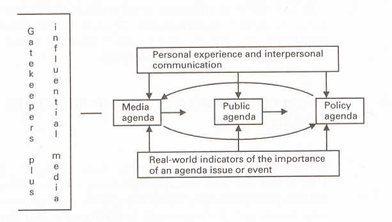Agenda Setting Theory
Agenda setting is a theory of mass communication that describes the way in which the mass media interacts with and affects the public it targets. At the core of the theory is the notion that mass media forms the primary interface between the public and the world around them. The media, therefore, wield considerable control over the public’s perception of the world around them. This control takes the form not only of what to think about, but also how to think about it. The arguments made by agenda setting have a profound impact on societal level communication and the role of media as a communicative transit.[1]
Agenda setting describes a very powerful influence of the media – the ability to tell us what issues are important. As far back as 1922, the newspaper columnist Walter Lippman was concerned that the media had the power to present images to the public. McCombs and Shaw investigated presidential campaigns in 1968, 1972 and 1976. In the research done in 1968 they focused on two elements: awareness and information. Investigating the agenda-setting function of the mass media, they attempted to assess the relationship between what voters in one community said were important issues and the actual content of the media messages used during the campaign. McCombs and Shaw concluded that the mass media exerted a significant influence on what voters considered to be the major issues of the campaign.[2]
Core Assumptions and Statements[3]
Agenda-setting is the creation of public awareness and concern of salient issues by the news media. Two basic assumptions underlie most researches on agenda-setting:
- the press and the media do not reflect reality; they filter and shape it;
- media concentration on a few issues and subjects leads the public to perceive those issues as more important than other issues.
One of the most critical aspects in the concept of an agenda-setting role of mass communication is the time frame for this phenomenon. In addition, different media have different agenda-setting potential.
Conceptual Model

source: University of Twente
References
Further Reading
- The Agenda-Setting Role of the Mass Media in the Shaping of Public Opinion Info America
- Agenda Setting: Definition, Function, Process & Examples Study.com
- A Look at Agenda-setting: past, present and future IPFW
